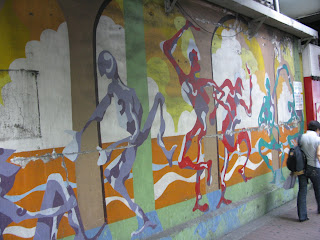After a couple of fairly uninteresting stops, I was hoping that Gotanda would have more to offer for the casual visitor. And on exiting the station, the fact that surroundings weren't just a mass of glass and concrete was a promising sign.
The east exit takes you to the area that lies inside the loop of the Yamanote Line, and the main road takes you uphill towards the Seisen University campus.
Tucked away behind the facade of an office block there is this shrine. As with many shrines in Japan, however, big or small, demolition is out of the question, as it would be inviting bad luck to that site in the future. Consequently, with the massive programme of urbanisation that has been in place since the war, if a shrine has been located on a prime piece of land, and the developers had the go ahead to build on that land, the shrine has remained in tact and the building has been built around it. Apparently hemming the gods in from all sides is permissible.
Further up the hill is the huge, but rather strangely shaped Honryu-ji, clearly a major temple in the area give the size of the grounds and the cemetery attached, but hardly the most eye-catching.A cowboy with a swag bag outside a motorbike repair shop.
Gotanda seems to have a number of small but popular eateries in its back streets, such as this van selling take out bentos or the rickety old ramen shop below.
Heading back towards the station to explore the west side, I saw this picture in the window of a karaoke pub, perhaps depicting the ultimate salaryman fantasy ~ a kimono-clad hostess who is also handy with a set of golf clubs.
Murals beneath the arches at Gotanda station.Trains over the Meguro-gawa.
The western side of Gotanda is more of a residential area with lots of apartment blocks and shops, though near the station there are side streets with cramped restaurants (as above) and buildings packed with karaoke pubs, hostess bars and other less salubrious establishments (below).
A cafe called Angel Fake ~ I'd much rather have the real thing.
Another example of a building going up around a holy spot, though in this case a very tiny one.
Back near the station, an incredibly small yaki-tori shack.
A rather apt name for a love hotel perhaps.
I'm not quite sure what this company sells or what service it provides, but this phrase could be used to describe Tokyo in general, as in most areas there is usually something interesting or exciting going on.
Gotanda made for a pleasant stroll and was a relief after the last couple of stops. 


























Not sure if it's true, but I was told recently on a tour that if there is a tiny torii (picture or material), it means 'do not pee' because even drunks aren't supposed to pee within sight of a torii.
ReplyDelete